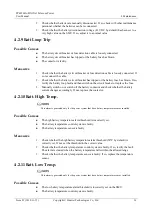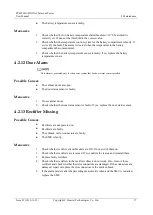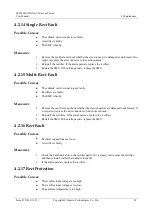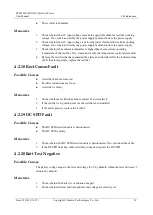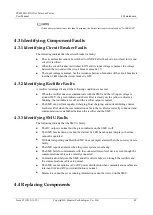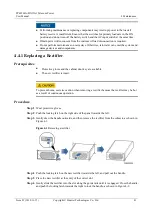
TP48200A-DX12A1 Telecom Power
User Manual
4 Maintenance
Issue 07 (2019-11-15)
Copyright © Huawei Technologies Co., Ltd.
35
4.
Check whether the system voltage is set too low in manual mode. If yes, confirm the
reason and adjust the voltage to a proper value after the operation.
5.
Check whether the power system capacity is insufficient for the loads due to rectifier
failures. If yes, replace the faulty rectifier.
4.2.6 Batt Chg. Overcur.
Possible Causes
Rectifier communication is interrupted.
SMU connections are loose.
The SMU is faulty.
Measures
1.
Check whether an alarm has been generated for interrupted rectifier communication. If
so, remove the rectifier, reinstall it, and check whether the alarm is cleared. If the alarm
still exists, replace the rectifier.
2.
Remove the SMU, reinstall it, and check whether the alarm is cleared. If the alarm still
exists, replace the SMU.
4.2.7 LLVD Disconnected
Possible Causes
An AC power failure has occurred.
Loads are manually disconnected.
The load disconnection voltage has been set to a very high value on the SMU.
Measures
1.
Check whether an AC power failure has occurred. If so, rectify the fault to restore the
AC power supply.
2.
Check whether loads are manually disconnected. If so, check with other maintenance
personnel whether the loads can be reconnected.
3.
Check whether the load disconnection voltage (44 V DC by default) has been set to a
very high value on the SMU. If so, adjust it to a normal value.
4.2.8 BLVD Disconnected
Possible Causes
An AC power failure has occurred.
Batteries are manually disconnected.
The battery disconnection voltage has been set to a very high value on the SMU.
Measures
1.
Check whether an AC power failure has occurred. If so, rectify the fault to restore the
AC power supply.
















